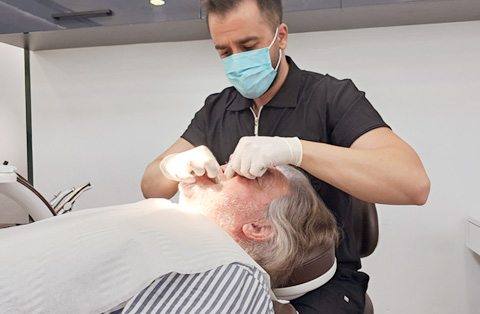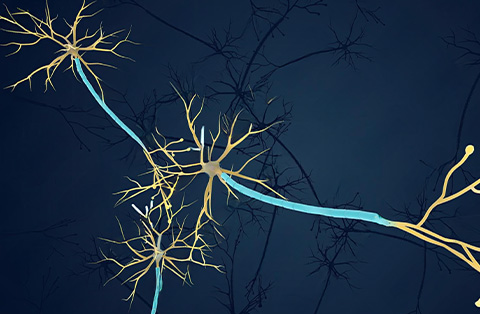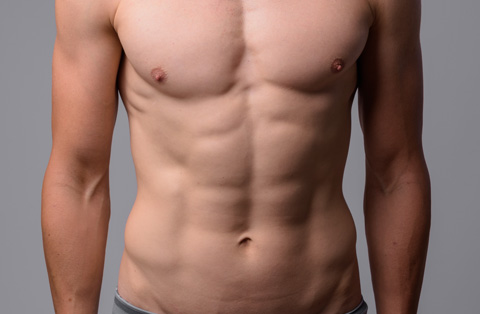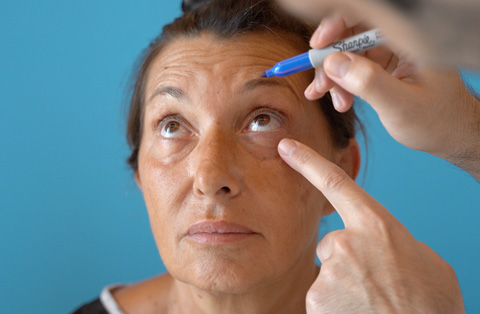Struggling with dry eyes from contact lenses? Discover causes, symptoms, and expert solutions to manage dryness, protect vision, and keep lens wear comfortable every day.
Dry eye syndrome happens when the eyes don’t stay properly lubricated, leading to irritation, burning, or blurred vision.
Contact lens-related dry eye is one of the most common problems for lens wearers, affecting comfort and long-term eye care. Studies suggest that up to half of contact lens users report some degree of dryness.
In this article, we’ll explain what dry eye syndrome is, why contact lenses can make it worse, which lens types matter, and how to manage symptoms with proven treatments and prevention strategies.
What is dry eye syndrome?
Dry eye syndrome is a condition where the eyes do not produce enough tears, or the tears evaporate too quickly. Tears are essential for lubricating the eye surface, protecting against infection, and ensuring clear vision.
When the tear film becomes unstable, the eye surface dries out. This leads to discomfort, irritation, and in many cases, visual disturbances. The condition ranges from mild dryness to chronic eye surface inflammation that can affect daily activities.
Dry eye syndrome is often linked to aging, hormonal changes, certain medications, or environmental factors. Contact lens wear can also contribute by disrupting the tear film balance, which makes understanding this condition important for people who wear contacts.
Does wearing contact lenses cause dry eyes?
Wearing contact lenses can contribute to dry eyes, but the effect depends on lens type, fit, and individual tear quality. Lenses sit directly on the eye surface and interact with the tear film. This can reduce natural tear exchange and increase evaporation.
Soft contact lenses often absorb part of the tear film, leaving less moisture on the cornea. Rigid gas-permeable lenses, while less absorbent, may still cause dryness by disrupting tear flow. Extended wear and older lens materials generally carry a higher risk of dryness.
Not everyone who wears contact lenses develops dry eye. People with pre-existing tear film instability, allergies, or systemic conditions are more likely to experience symptoms. Environmental factors, such as air conditioning or prolonged screen use, can intensify lens-related dryness.
How contacts worsen dry eye symptoms?
Contact lenses can intensify dry eye symptoms by disturbing the tear film that protects the eye surface. When the tear layer becomes unstable, the eye dries more quickly, and discomfort increases.
The presence of a lens reduces oxygen reaching the cornea and changes how tears spread across the eye. This can lead to burning, stinging, and a persistent gritty feeling. Symptoms often worsen toward the end of the day as lenses dry out.
Lens materials also play a role. Some absorb more moisture, pulling water away from the tear film and leaving the surface drier. Thin tear films may break up faster over lenses, causing blurred vision and fluctuating clarity.
People with existing dry eye syndrome often notice amplified irritation when wearing contacts. The combination of tear film instability and lens wear makes the eyes more sensitive to environmental triggers like wind, smoke, or screen use.
How does types of contact lenses affect dry eyes?
Different contact lens types influence dry eye severity in distinct ways. Soft hydrogel lenses, made of water-containing materials, can dehydrate during wear. As they lose moisture, they pull water from the tear film, leading to dryness and end-of-day discomfort.
Silicone hydrogel lenses allow more oxygen to reach the cornea compared to traditional hydrogels. However, they can sometimes interact poorly with the lipid layer of tears, causing uneven wetting and increased evaporation.
Rigid gas-permeable lenses cover a smaller portion of the eye surface. They allow tears to circulate beneath the lens, which may help maintain stability in some dry eye patients. Still, their initial adaptation period can cause irritation.
Scleral lenses create a fluid reservoir between the lens and the cornea. This design can shield the eye from evaporation and protect against dryness, making them useful for severe dry eye syndrome.
Disposable lenses replaced daily reduce protein buildup and dehydration, often making them more comfortable for people prone to dryness. By contrast, extended-wear lenses increase the risk of dry eye symptoms due to reduced tear exchange and surface exposure.
Dry eye treatment for contact lens wearers
Treatment for dry eye in contact lens wearers focuses on restoring tear film stability, reducing irritation, and protecting vision. Management usually combines changes in lens use with medical or supportive therapies.
1. Lens-related strategies
Daily disposable lenses: Fresh lenses each day reduce protein deposits and dehydration.
Material selection: Silicone hydrogel or scleral lenses may help improve oxygen delivery and moisture balance.
Wearing schedule: Shorter wear times and avoiding overnight use lessen stress on the tear film.
2. Tear supplementation and hydration
Lubricating eye drops: Preservative-free artificial tears replace moisture and relieve dryness.
Rewetting drops: Designed for contact lenses, they improve surface comfort during wear.
Hydration habits: Drinking enough water and using humidifiers help maintain systemic and environmental tear support.
3. Medical and supportive treatments
Anti-inflammatory drops: Prescription agents reduce inflammation contributing to tear instability.
Punctal plugs: Small devices inserted into tear ducts slow tear drainage and extend moisture on the eye surface.
Omega-3 supplementation: Dietary intake of fatty acids may support the lipid layer of tears, improving stability.
4. Environmental and behavioral adjustments
Screen breaks: Regular blinking during screen use reduces evaporation.
Protective eyewear: Glasses or moisture chambers shield against wind and dry air.
Lifestyle adjustments: Avoiding smoking, controlling allergies, and managing systemic health conditions can reduce worsening factors.
Effective treatment often requires tailoring. Some patients improve with lens changes alone, while others need combined medical therapy. Ophthalmologists may recommend stepping up from conservative measures to advanced interventions if symptoms persist.
How to manage dry eye associated with contact lens?
Managing dry eye with contact lenses requires consistent habits that protect the tear film and reduce irritation. The goal is to keep the eyes hydrated while maintaining safe lens wear.
Choose appropriate lenses
Daily disposable lenses lower the risk of dryness by avoiding buildup and dehydration.
Scleral lenses can create a tear-filled cushion for those with more advanced dry eye.
Modify wear schedule
Limiting the number of hours lenses are worn each day helps prevent end-of-day dryness.
Removing lenses during activities that strain the eyes, such as long screen sessions, can reduce symptoms.
Use supportive therapies
Lubricating drops safe for contact lenses help restore comfort throughout the day.
Rewetting drops may reduce friction between the lens and the eye surface.
Improve the environment
Humidifiers at home or work prevent air from drying out tears.
Protective eyewear shields against wind, dust, and air conditioning.
Adopt healthy habits
Regular blinking during screen time lowers evaporation.
Adequate hydration and omega-3 intake support tear quality.
Seek professional guidance
Eye specialists can adjust lens type, fit, or prescribe treatments if dryness persists.
Monitoring for signs of worsening dry eye syndrome ensures early intervention.
These strategies do not cure dry eye but help contact lens wearers keep symptoms manageable and maintain visual comfort.
When should I see an eye doctor?
You should consult an eye doctor if dry eye symptoms persist despite using lubricating drops or adjusting contact lens wear. Ongoing irritation, redness, or blurred vision may indicate more than simple dryness.
Medical attention is especially important if:
Pain, burning, or stinging worsens over time.
You experience sudden changes in vision, such as fluctuating clarity or difficulty focusing.
Contact lenses feel consistently uncomfortable, even after switching brands or materials.
Your eyes remain red, watery, or inflamed after lens removal.
You notice sensitivity to light, which may signal corneal involvement.
Seeing an eye doctor ensures a proper diagnosis and tailored treatment. In some cases, dry eye syndrome coexists with allergies, infections, or eyelid conditions that require medical care. Early evaluation helps prevent complications and protects long-term eye health.
Frequently Asked Questions
Can I wear contacts with dry eye syndrome?
Yes, you can often wear contacts with dry eye syndrome, but comfort depends on lens type and severity of symptoms. Daily disposable or scleral lenses may help reduce irritation by supporting tear stability. An eye doctor can recommend safe options and ensure lenses don’t worsen underlying dry eye.
What to avoid with dry eye syndrome?
People with dry eye syndrome should avoid environments that increase tear evaporation, such as wind, smoke, and air-conditioned spaces. Limit prolonged screen use without blinking breaks. Stay away from poorly fitting or extended-wear contact lenses that worsen dryness. Avoiding these triggers helps protect tear stability and reduce daily discomfort.
How to lubricate eyes while wearing contacts?
Use preservative-free lubricating drops that are labeled safe for contact lenses. These rewetting drops restore moisture and reduce friction between the lens and eye surface. Apply them as needed during the day, especially in dry environments or while using screens. Avoid standard eye drops not designed for lens wear.
Which contact lenses are best for dry eyes?
Daily disposable lenses are often best for dry eyes since they reduce buildup and maintain moisture. Scleral lenses can also help by creating a fluid reservoir that protects the eye surface. Silicone hydrogel lenses provide higher oxygen flow, though results vary. An eye doctor can match lens type to individual needs.
How long can you wear contacts with dry eyes?
People with dry eyes should limit contact lens wear to shorter periods, often 6–8 hours, depending on comfort. Extended wear increases dryness and irritation. Daily disposable lenses are generally safer because they reduce dehydration and buildup. Your eye doctor can set personalized limits based on tear stability and lens type.





